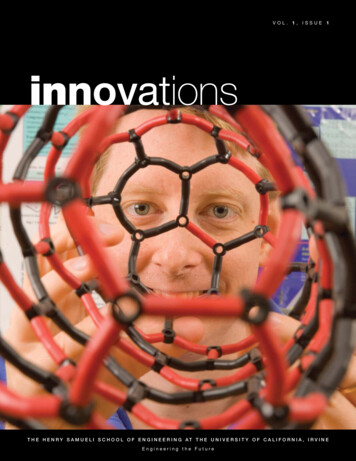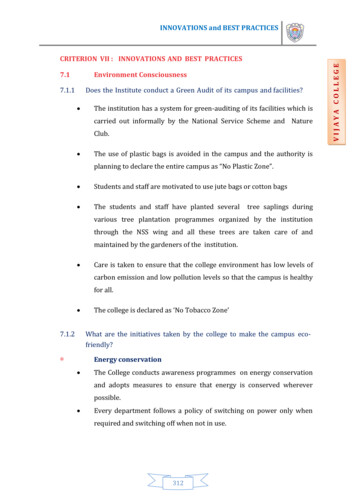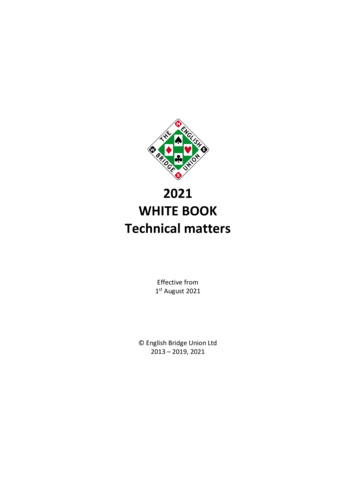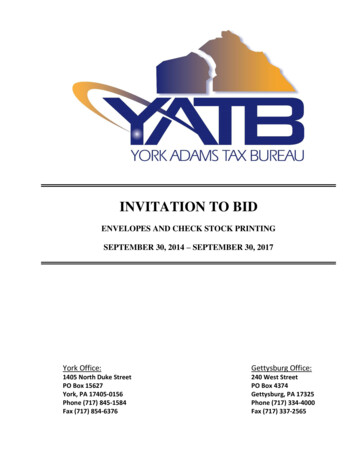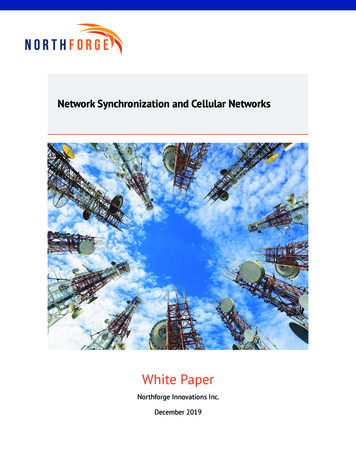
Transcription
Network Synchronization and Cellular NetworksWhite PaperNorthforge Innovations Inc.December 20191
What Time Is It?This is a question that is asked a million times a day. It could be that you just want to know because you need to dosomething or be somewhere at a particular time. Or, it might be that you want to set your watch. Either way, your goalis for two things to have the same time. Making two things agree on the time is called synchronization.Usually when we make two clocks agree on the time, we don’t also make them tick at the same rate—there isn’tan easy way to do this—so the clocks will immediately begin to diverge. If we need the two clock to stay closelysynchronized, we have to try harder.The simplest way is to resynchronize frequently. If I ask you “what time is it?” every 10 minutes, our watches will staypretty close even if they are ticking at different rates. This is not very efficient, but it works (although we might notremain friends very long).On the other hand, if I could change the ticking rate of my watch to be closer to your watch, then our watches willstay closer even if we don’t resynchronize frequently. Making two clocks tick at close to the same rate is clearly amore efficient solution. This is called syntonization (or “frequency synchronization”). Syntonization is a much betterapproach if we need to keep our clocks synchronized. With synchronization I will only need to ask “what time is it?”maybe once a day (and it might preserve our friendship).All of our computers run NTP (Network Time Protocol) to synchronize their system clocks to a reference clock, i.e.,an NTP server. A “good” NTP server is synchronized to a very high-quality reference clock like GPS or an atomicclock, which we refer to as a Primary Reference Clock (PRC). There are so many everyday applications that dependon having the “correct” time: sending and receiving email; synchronizing shared files and databases; time stampingtransactions, etc. If the computers didn’t have the same time many of these activities wouldn’t work correctly (e.g., anewer file might be overwritten by an older file).Synchronizing our computers within a half second or so is sufficient for many of these activities (as opposed to aminute or two for our everyday lives). The accuracy of NTP depends on the quality of the network. Long delaysand high variation in the amount of delay make synchronization difficult (more on this in the next white paper).NTP across a LAN can provide very tight synchronization (on the order of 1–5 ms), but across the Internet it can beanywhere from about 10ms to a second. NTP allows us to synchronize time but not frequency. Applications thatrequire very tight synchronization (milliseconds or microseconds) need a better solution and that solution will likelyinclude syntonization as well as synchronization.Why Do We Care?We implement time synchronization on our computers, but we don’t worry about frequency synchronization; we justresynchronize the time on a regular basis—our computers aren’t frequency synchronized to the NTP server. But that’sok, it just means that we will drift away and get pulled back the next we synchronize. But our computers are not theonly application out there.2
Thanks to Cell PhonesThe recent (last ten years or so) interest in network synchronization has been focused on cellular (mobile) networks.There are many different cellular network technologies and they all require frequency synchronization betweenthe various components. These timing signals are used for generating the radio frequencies for transmission andtherefore the syntonization must be very accurate and very stable. As shown in Figure 1, most cellular technologiesrequire accuracy of 50 parts per billion (i.e., if the frequency is 1GHz, it has to be 50 Hz).ApplicationCDMAFrequency (ppb)Phase (µs) 50CDMA2000 50Time (µs)Reference Document 3(Traceable & Synchronousto UTC)TIA/EIA-95-B 10 ( 8hrs) whenexternal timing sourcedisconnected 3 (Traceable &Synchronous to UTC)3GPP2C.S0002-E v2.0C.S0010-C v2.0GSM 50 100 (pico BS)ETSITS 145.010UMTS-FDD(WCDMA) 50 (Wide area BS)12.8 100 (Medium range BS) (MBSFN-3GPP Release 7/8) 100 (Local area BS) 250 (Home BS)3GPPFrequency: TS 25.104MBSFN:TS 25.346UMTS-TDD(WCDMA) 50 (Wide area) 100 (Local area) 250 (Home eNB) 2.5 1 (between Macro eNB and Home eNB)3GPPFrequency: TS 25.105Phase: TS 25.402Home eNB: TR 25.866TD-SCDMA 50 33GPPTS 25.123LTE (FDD) 50 (Wide area) 100 (Local area) 250 (Home eNB)CDMA handover and SynchronizedE-UTRANGPS time 10 ( 8hours) when external timingsource disconnected3GPPFrequency: TS 36.104Time: TS 36.133LTE (TDD) 50 3 (small cell) 10 (large cell)3GPPFrequency: TR36.922Phase & Time: TS36.133CDMA handover and SynchronizedE-UTRANGPS time 10 ( 8hours) when external timingsource disconnectedMobileWiMAX 2000 (i.e., 2ppm) 1IEEE 802.16-2009WMF-T23-001-R015v01Figure 1. Synchronization Requirements for Cellular Technologies (Reproduced with permission of MEF Forum)3
In addition to frequency synchronization, most of the cellular technologies also require phase1 or timesynchronization. This has several purposes, including time slot definitions for technologies that use the samefrequency bands for upstream and downstream traffic. Time synchronization can also be useful for E911 support.The Radio Access Network (RAN)The network from the packet core/network control center to the Base Station (i.e., the cell tower) is called the RadioAccess Network or RAN. The RAN has two major components: Backhaul, which is a packet network that carries datafrom the packet core to the Base Band Unit (BBU); and Fronthaul which carries digitized radio signals from the BBU tothe Remote Radio Head (RRH)/antenna.The BBU converts user data (e.g., IP Packets from the Internet delivered over the Backhaul Network) into a bit streamthat digitally encodes the RF signal that is sent out over the antenna. This IQ bit stream (In-Phase and Quadrature)is sent over the Fronthaul Network using one of two protocols: CPRI (Common Public Radio Interface) or OBSAI(Open Base Station Architecture Initiative). The RRH converts the IQ stream into analog RF signals that are fed to theantenna. And, of course, the process also runs in the other ulBBU NetworkBase StationBase StationFigure 2. RAN Components – Backhaul and FronthaulTraditionally, the BBU was located at the Base Station, so the Backhaul ran all the way from the network controlcenter/packet core to the cell site and the Fronthaul was entirely within the cell site. This is shown in the left-handdiagram in Figure 2.Increasingly, the Base Band Units are being moved from the Base Station into a centralized location (sometimesreferred to as a BBU Hotel), and the fronthaul network extends from there to the cell site. Since much of thefunctionality of the BBU is software, the BBU software can be run in virtual machines on standard servers (withspecial network interfaces) with all of the concomitant benefits: reduced cost, higher availability, greater flexibility,etc. Also, much less hardware is needed at each cell tower reducing cost, power, and maintenance. This is especiallyimportant for small cells (see above). This is shown in the right-hand diagram in Figure 2.1 hase synchronization means that the two clocks are ticking at the same instant in time. This clearly requires frequency synchronization, but the reverse is notPtrue. Frequency synchronization only requires that the two clocks are ticking at the same rate, but the ticks don’t have to happen at the same instant. Timesynchronization does require phase synchronization and is often called “absolute” phase synchronization.4
BackhaulBackhaul for 2G and 3G networks was provided with T1/E1 and SONET/SDH and ATM.T1/E1 and SONET/SDH are synchronous network architectures.2 A synchronous network architecture is one in whichthe physical transmission rate of data on the wire (or fiber) is transferred from link to link through the network.A node receives a frequency reference from a reference clock (a Primary Reference Clock or PRC) and uses thatfrequency to create the transmit clock on its interfaces. Nodes that receive data from that node lock onto that receiveclock, clean it up, and use it to create the transmit clock on their interfaces. And so on. As a result, all of the links inthe network are transmitting data with a clock that is derived from the PRC. This is shown in Figure 3.Primary Reference ClockSONET/SDH RingFigure 3 Synchronous NetworkThis is physical layer clocking. There is no data being sent on the network links to transport the clock3 to the nextnode, rather, the application data bits (cellular network packets, e.g., your photos and email) are being transmittedonto the links using the network clock as the “bit” clock. In essence, the network links are a set of metronomesthat are all ticking at the same rate. Using a common source for clock ticking (frequency) is one way to achievesyntonization. All of the BBUs listen to these metronomes and are very accurately frequency synchronized.4As cellular technology moved into higher speed 3G and then 4G/LTE, Ethernet-based backhaul became the norm.Traditionally, Ethernet is an asynchronous network architecture. In an asynchronous network architecture, each nodetransmits based on its own internal (“free-running”) clock usually based on an oscillator inside the node. This meansthat if node A connects to node B, data from A to B use A’s oscillator, and data from B to A use B’s oscillator. To make2 T1/E1 networks are actually plesiochronous or “almost synchronous”. But we discuss it as a synchronous network.3There might be management information being passed between the nodes relating to the clock, but the clock itself doesn’t require any data to be transferred.4 hysical layer clocks are also stable, i.e., the frequency variation over time is small. There are no traffic delay or queueing issues at the physical layer, it is just a bitPstream. Factors like temperature variation can have an impact on some components like oscillators and PLLs causing a little drift.5
matters worse, the Ethernet standard allows these oscillators to be relatively sloppy ( 100ppm)5, so the data traveling indifferent directions on the same Ethernet cable could have bit rates that differ by as much as 200ppm! (Compare this tothe 50ppb requirement in the cellular networks.) So, an Ethernet network can’t be used as a metronome like a T1/E1 orSONET/SDH network. This creates a dilemma. One one hand, Ethernet provides very high transfer rates at much lowercost than SONET/SDH, and is more appropriate for carrying packet data (and packet data has long surpassed voice as theprimary use of the cellular network). But, on the other hand, Ethernet does not provide the necessary syntonization forthe cellular network and SONET/SDH does. And don’t forget, we still need time synchronization, in both cases.How Have These Issues Been Addressed?Clearly, LTE networks have been running with Ethernet backhaul for a while. How have the issues been dealtwith to date? The primary solution has been the use of GNSS (Global Navigation Satellite Systems) such as GPS inNorth America. These systems provide high-quality, multi-source signals that transfer frequency, phase, and timesynchronization. GPS receivers placed on cell-towers can provide the necessary synchronization for the network.But there are three problems with using GNSS:1. P olitics – GNSS systems are run by national governments (and frequently, the military) and there are only a fewof these systems. So, a country has to be willing to base its cellular network on the goodwill (and competence) ofanother country.2. C ost – GNSS receivers and the electronics necessary to generate high quality synchronization from the GNSS areexpensive.3. Visibility – To use a satellite-based solution, the receiver has to be able to see multiple satellites.Changes in Cellular NetworksIn order to increase coverage, 4G networks introduced small cells (femtocells, picocells, microcells). As opposed to themacro cells that we are used to seeing on the tops of really tall cell towers, small cells are, well, small. They are compactdevices that can be inside small packages, inside residences or businesses, or even inside fake cacti.Since 4G, and to an even greater extent 5G, is focused on providing very high data rates to a large number of users (onetarget application for 5G is the Internet of Things which means millions of individual devices per square km), the use ofsmall cells is increasingly important. 5G deployment is heavily focused on small cells.Small cells pose an additional challenge—actually two. First, by their nature, there are many of them and they are muchless expensive than macro cells. So, including GPS components on every one of them wrecks the economics. Secondly,they are often inside homes, businesses, stadiums, etc. and don’t have a clear view to multiple GPS satellites. Also, smallcells are used, increasingly, in cities where large buildings also block the view.5 his explains why Ethernet packets have a long preamble with a well-defined pattern (8 bytes). The receiving node needs time to sync up to the data that is comingTin since it is being sent based on the transmitter’s clock. This ends up making Ethernet less efficient (wasting 8 byte times for every packet) but also less expensive.6
Now We Know What the Problem IsWe have laid out the problem, i.e., past solutions won’t work for contemporary/future deployments. We want to useEthernet instead of synchronous solutions such as T1/E1, and we are deploying small cells that make GNSS/GPS botheconomically and technically infeasible. But we still need frequency and time synchronization in the cellular network!In the next white paper, we discuss the modern solutions to these problems. We will discuss Synchronous Ethernet, whichmakes Ethernet look more like SONET/SDH, and Precision Time Protocol (PTP), a packet-based solution (protocol) thatcan be used for high-quality frequency and time synchronization. We will discuss some of the implementation issues andchallenges with these solutions and how Northforge has assisted customers in developing some of these solutions.About Northforge Innovations Inc.Northforge Innovations is an expert software consulting and development company focused on advancingnetwork communications. We target network security, network infrastructure, and media services, with themission and passion to meet the industry’s demands in the evolving cloud infrastructure, virtualization andsoftware-defined networking.With an average of 15 years of experience, our consultants comprise a worldwide resource pool that’s based inNorth America. Northforge employs top technical and project management talent to give customers the “intellectualcapital” they need for their network communications software development. Our developers have extensivetechnical and domain expertise across a breadth of technologies. With expertise extending beyond softwaredevelopment services, our team tackles our customer’s most demanding challenges and delivers innovativesolutions. Our culture stresses innovation at every step, from our ability to understand and address our customers’needs, our constant exchange of innovative ideas to the continuous value that we create for our customers.For more information about Northforge Innovations Inc., please visit www.gonorthforge.com.NORTHFORGE INNOVATIONS INC.GATINEAU DEVELOPMENT CENTER(Development Center)72 Laval Street, 3rd LevelGatineau (QC) J8X 3H3USA OFFICE(Sales Office)One Boston Place, Suite 2600Boston, MA 02108MONTREAL DEVELOPMENT CENTER1130 rue Sherbrooke Ouest, Suite 430Montréal, QC H3A 2M8General Inquiries 819.776.6066Consulting Inquiries .comNORTHFORGE INNOVATIONS ISRAEL LTD.10 Zarchin St.Ra’anana 4366238PO Box 4318IsraelCopyright 2019 - Northforge Innovations Inc.7
SONET/SDH network. This creates a dilemma. One one hand, Ethernet provides very high transfer rates at much lower cost than SONET/SDH, and is more appropriate for carrying packet data (and packet data has long surpassed voice as the primary use of the cellular network). But, on the other hand, Ethernet does not provide the necessary .



